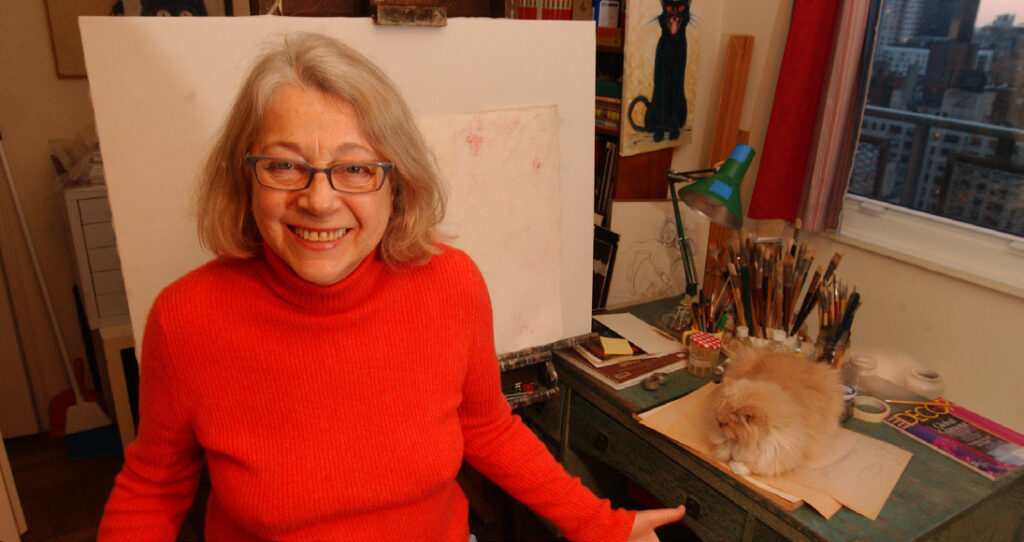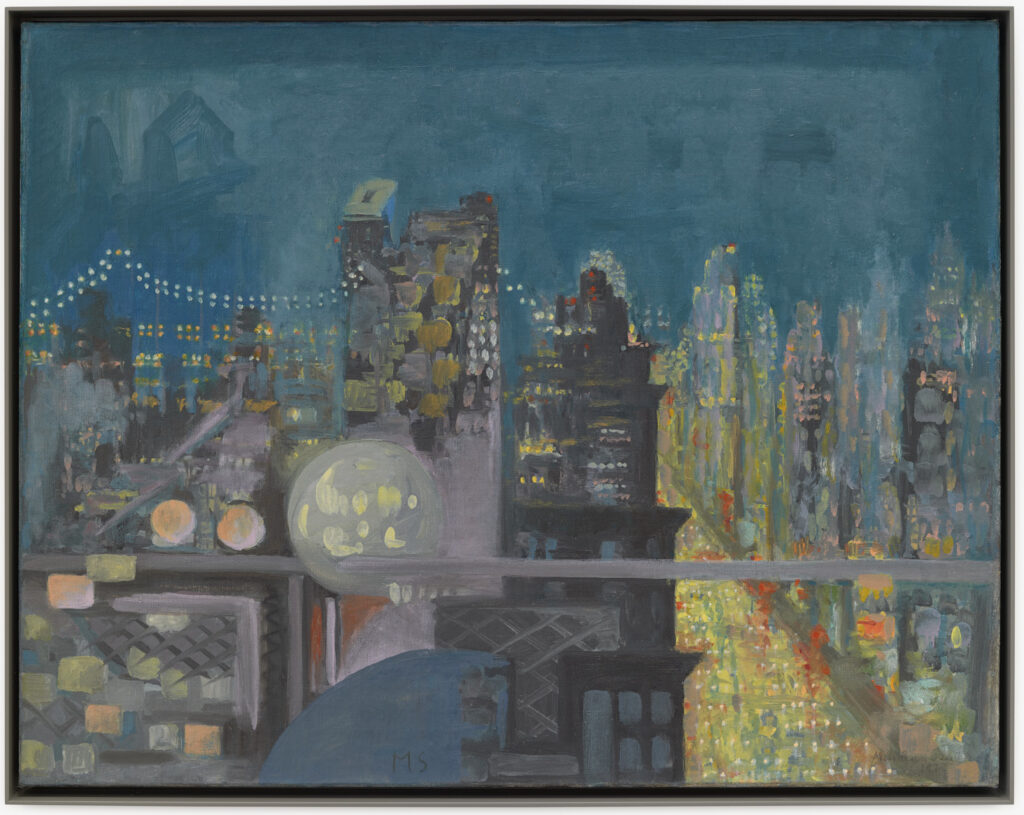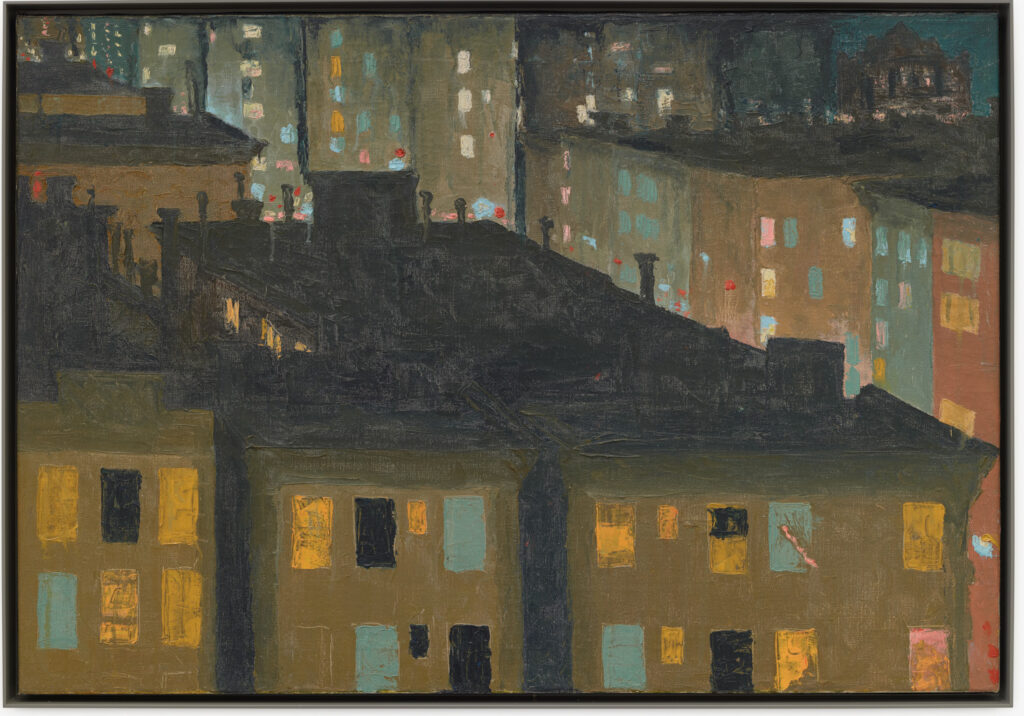
Martha Szabo, an artist who worked steadily for 70 years, producing hundreds of paintings, never actively promoting her work, exhibiting only rarely, and finally achieving belated recognition in her last year of life, died on December 18, 2023 at 5:53 am. She was 95.
In tribute, her daughter and sole survivor, Julia Szabo, is establishing MSeum, the world’s first museum to be built by women, a non-profit whose mission, “Know Unknowns,” is inspired by the career of her prolific yet under-recognized artist mother.
“Martha Szabo produced a breathtaking scope of work, in styles ranging from landscape to figuration to abstraction, geometry, and surrealism, across many mediums: oil painting and watercolors, drawing, assemblage, sculpture, screen printing, and photography, which she developed and printed herself,” said David Eichholtz of Chelsea’s David Richard Gallery, who curated “Up On The Roof: Liberation, Transformation, Celebration,” a solo presentation of cityscapes spanning five decades of her career, many of them produced from her apartment’s rooftop POV. The exhibition closed November 17, 2023, one month before the artist’s death. Eichholtz first encountered Szabo’s work in 2021 and immediately added her to his roster of artists, which also includes Sonia Gechtoff, Nancy Genn, and Dee Shapiro. Accompanying Szabo’s exhibition was a catalogue essay by the distinguished art historian Gwen Chanzit, Curator Emerita, Denver Art Museum and author of Women of Abstract Expressionism. Comparing Szabo to Monet and Van Gogh, Chanzit writes, “These windowed paintings… are primarily cityscapes of imagination, a masterful record of place in lively dialogue between the external world and inward expression in front of that glass divide.”

Born Marta Weisz in Debrecen, Hungary, on October 25, 1928, Szabo exhibited artistic talent as early as age 8, and by age 15 had committed to a career in art, intending to study in Paris. World War II and the Nazi persecution of Jews disrupted her plans; in 1944, together with her parents and siblings, she was relocated to a ghetto, then interned at the Strasshof Concentration Camp in Austria, forced to carry bricks and mortar to other prisoners working in construction, and ordered to collect debris after air raids in Vienna.

At the end of the war, the Strasshof Camp was liberated by the Soviets; the Weisz family traveled on foot back to Debrecen, a journey that took three weeks. Her father changed the family’s surname to Varga, so as to sound less Jewish. Earning her MFA at the University of the Fine Arts, Budapest, Marta Varga married the archaeologist (later art historian and museum curator) George Szabo, 1928–2016. Increasingly dismayed by Soviet destruction of important Magyar monuments, the couple left their homeland, immigrating to the United States in 1957, part of President Eisenhower’s Operation Safe Haven.

Once in New York, Szabo’s creativity flourished. Enchanted by her new home city, especially its tall buildings and energetic construction activity—a refreshing change
from the crumbling buildings she witnessed in Europe during and after the war—Szabo began painting New York’s architecture, people and, later, in the 2000s, animal companions. In the late 1980s and early 1990s, she enjoyed capturing the studio scene at the Art Students League, where she was a proud Life Member, celebrating models and her fellow creatives in deftly executed portrait studies that were decades ahead of today’s accent on inclusion and diversity.
Always an intensely private person, modest and reticent about her work, Szabo found purpose and peace in contemplation of the Metropolitan skyline from the vantage point of her apartment’s 22nd floor windows (the Szabo family moved to the building’s top floor in 1965). From her art studio’s unique POV, she recorded the architectural drama unfolding as the NYC of Mayor John V. Lindsay experienced its golden era of energetic planning, master building, and construction. Szabo gave equal attention to tall, modern structures (notably the Seagram Building, a favorite) and to the expressive rooftops and stalwart water-tank towers of older, shorter buildings that withstood the built environment’s sixties-seventies seismic shift.

It was balm for the artist’s spirit to rise early and stay up late, chronicling how natural phenomena burnished her imperial city view with cloud formations, sunrises, sunsets, crescent moons, even rainbows. Szabo’s dazzling nocturnes wear the bright lights of her beloved Queensboro Bridge and passing vehicles below like a regal parure. New York City unfolded a fantastic daily and nightly drama for the artist who, while designing theatrical costumes as an MFA student, related profoundly to La Vida es Sueno (Life is a Dream) by Pedro Calderon de la Barca, the “Spanish Shakespeare.”
Her legacy leaves art lovers of today and tomorrow with meditative paintings that skillfully capture the effects of early morning on snowy rooftops, foggy afternoons on the East River, and recurring fleets of mysterious, voluptuous silhouettes traversing the urban horizon, described by the artist as “The souls of transformed buildings, celebrating.”

Now, it is the art world’s turn to celebrate her. Says Kathleen Hulser, public historian, former curator at the New-York Historical Society, now MSeum Executive Director, “Martha Szabo exemplifies the sort of artist at the heart of the MSeum mission: talented, active, underacknowledged. As one of a large cohort of unknowns on the path to becoming known, the women artists born in the first half of the 20th century faced obstacles that constrained their careers. And yet, like Martha, so many persisted in the face of cultural silencing: turning again and again to their easels to paint strokes louder than words, the palette of women who refused to accept consignment to society’s dark corners. Martha brightened our world with her perceptive and unique portraits, and her probing geometries of New York
City roofscapes.” G&S





Leave a Comment